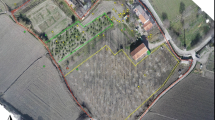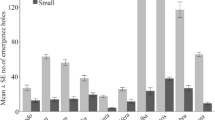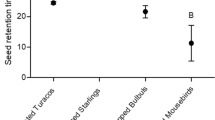Summary
Blue jays transported and cached 133,000 acorns from a stand of Quercus palustris trees in Blacksburg, Virginia, representing 54% of the total mast crop. A further 20% (49,000) of the mast crop was eaten by jays at the collecting site. A large proportion of the nuts remaining beneath the collecting trees was parasitized by curculionid larvae. The number of nuts transported per caching trip ranged from 1–5 with a mean of 2.2. Mean distance between seed trees and caches was 1.1 km (range: 100 m–1.9 km). Jays appeared to choose species with small- to medium-sized nuts (Quercus palustris, Q. phellos, Q. velutina, Fagus grandifolia) and avoided the larger nuts of Q. borealis and Q. alba.
Nuts were cached singly within a few meters of each other and were always covered with debris. Covering may improve germination and early growth by protecting the nut and radicle from desiccation. The vegetation structure of most suburban caching sites was analogous to open, disturbed environments in more natural landscapes. The presence of numerous Quercus seedlings in jay caching sites and the tendency for jays to cache nuts in environments conducive to germination and early growth indicate that blue jays facilitate colonization of members of the Fagaceae.
Similar content being viewed by others
References
Bossema I (1979) Jays and oaks: an eco-ethological study of a symbiosis. Behavior 20:1–117
Chettleburgh MR (1952) Observations on the collection and burial of acorns by jays in Hainault Forest. British Birds 45:359–364
Fowells HA (1965) Silvics of Forest Trees of the United States. U.S. Forest Service, United States Department of Agriculture. Washington, D.C.
Kilham L (1963) Food storing of red-bellied woodpeckers. Wilson Bulletin 70:107–113
Lay DW, Siegler HR (1937) The blue jay as a link between acorn and quail. Transactions of the American Wildlife Conference 2:579–581
Shaw SP (1971) Wildlife and oak management. pp 84–89, In: Northeastern Forest Experiment Station. Oak Symposium Proceedings. NE. Forest Exp. Sta., Upper Darby, PA.
Smith AJ (1975) Invasion and ecesis of bird disseminated woody plants in a temperate forest sere. Ecology 56:19–34
Smith CC, Follmer D. (1972) Food preferences of squirrels. Ecology 53:82–89
Short HL (1976) Composition and squirrel use of acorns of black and white oak groups. Journal of Wildlife Management 40:479–483
Van Dersal WR (1940) Utilization of oaks by birds and mammals. Journal of Wildlife Management 4:404–428
Author information
Authors and Affiliations
Rights and permissions
About this article
Cite this article
Darley-Hill, S., Johnson, W.C. Acorn dispersal by the blue jay (Cyanocitta cristata). Oecologia 50, 231–232 (1981). https://doi.org/10.1007/BF00348043
Received:
Issue Date:
DOI: https://doi.org/10.1007/BF00348043




